| Pseudorhina Temporal range: | |
|---|---|
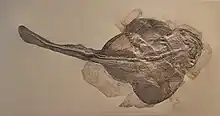 | |
| Fossil impression of Pseudorhina alifera (AMNH 7484) at the American Museum of Natural History | |
| Scientific classification | |
| Kingdom: | |
| Phylum: | |
| Class: | |
| Order: | |
| Family: | Pseudorhinidae |
| Genus: | Pseudorhina Jaekel, 1898 |
| Species | |
| |
Pseudorhina is an extinct genus of stem angel shark seemingly restricted to the Mesozoic of Europe.[1] It is represented by several articulated individuals as well as isolated teeth. There are currently four species.
Taxonomy and relationships
| Angel shark phylogeny | |||||||||||||||||||||
| |||||||||||||||||||||
| Relationships based on Maisley et al., 2020. |
Pseudorhina is currently the oldest known angel shark genus. It is thought to represent a basal offshoot within Squatiniformes and has been placed in a monotypic family called Pseudorhinidae. While most fossil genera and species of angel shark are represented solely by isolated teeth, Pseudorhina is relatively well known from articulated individuals. This allows a rare opportunity for detailed comparisons with other genera known from articulated remains including the extant Squatina.[2][3] Modern angel sharks are much more specialized than Pseudorhina, neurocrania show little morphological disparity in extant Squatina.[3]
Distribution and temporal range
All late Jurassic angel shark teeth currently known are attributed to Pseudorhina. The genus is currently restricted to Europe. P. acanthoderma is known from the late Kimmeridgian of Germany in layers which produce ammonites such as Hybonoticeras beckeri and Lithacoceras ulmense. It is known from both isolated teeth and associated material. P. alifera is known from the early Tithonian of Germany and similar teeth currently labeled as P. aff. alifera have been described from the Valanginian of France. Associated specimens are known. There seems to be another undescribed species with a unique tooth morphologynfrom the Tithonian of Germany. P. frequens is known only from isolated teeth from the early Kimmeridgian. P. crocheti is known from more than 250 isolated teeth from the Valanginian of France.[4][5]
Gallery
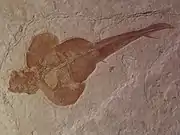 Pseudorhina alifera from the Kimmeridgian of Germany
Pseudorhina alifera from the Kimmeridgian of Germany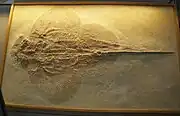 Pseudorhina alifera
Pseudorhina alifera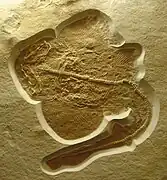 Pseudorhina
Pseudorhina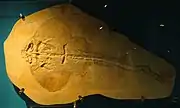 Pseudorhina alifera
Pseudorhina alifera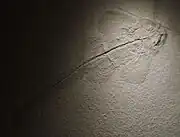 Pseudorhina asterodermus
Pseudorhina asterodermus Pseudorhina sp.
Pseudorhina sp.
References
- ↑ "Fossilworks: Pseudorhina". fossilworks.org. Retrieved 17 December 2021.
- ↑ Maisey, J. G., Ehret, D. J., & Denton, J. S. (2020). A new genus of Late Cretaceous angel shark (Elasmobranchii; Squatinidae), with comments on squatinid phylogeny. American Museum Novitates, 2020(3954), 1-29.
- 1 2 López-Romero, Faviel A.; Stumpf, Sebastian; Pfaff, Cathrin; Marramà, Giuseppe; Johanson, Zerina; Kriwet, Jürgen (2020-07-28). "Evolutionary trends of the conserved neurocranium shape in angel sharks (Squatiniformes, Elasmobranchii)". Scientific Reports. 10 (1): 12582. doi:10.1038/s41598-020-69525-7. ISSN 2045-2322. PMC 7387474. PMID 32724124.
- ↑ Klug, Stefanie & Kriwet, Jürgen. (2011). Node age estimations and the origin of angel sharks, Squatiniformes (Neoselachii, Squalomorphii). Journal of Vertebrate Paleontology. 31. 137. 10.1080/14772019.2012.674066.
- ↑ Guinot, G., Cappetta, H., & Adnet, S. (2014). A rare elasmobranch assemblage from the Valanginian (Lower Cretaceous) of southern France. Cretaceous Research, 48, 54-84.